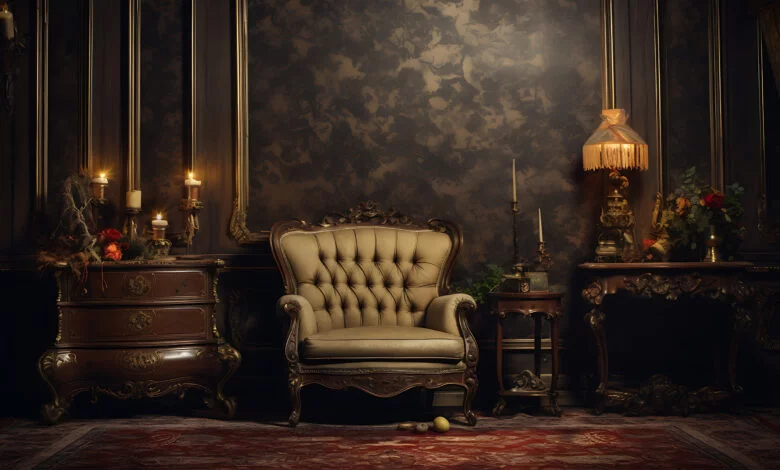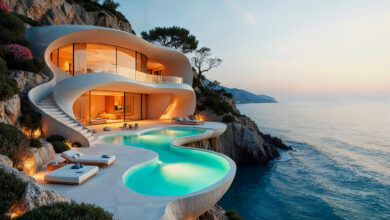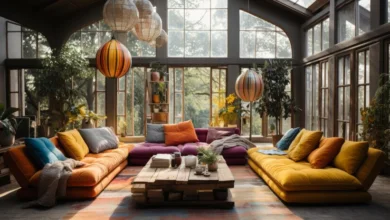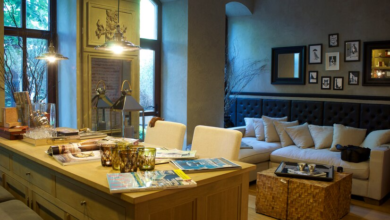
Traditional interior design is a timeless style that takes cues from the past and draws inspiration from the time-honored elements. Warm, rich color palettes, antique furnishings, classical patterns, and textures all make up a traditional home. This design style is a fine balance between comfort and formality that intertwines with elements from the present. Read on to discover how to keep up with the traditional design trends in 2025 that don’t just follow the times but bring a bit of the past into your present.
Origins of the Traditional Interior Design Style
Journey back to the 20th century, an era of postwar suburban expansion, where the roots of traditional interior design are found. Design enthusiasts took inspiration from the refined traditions of 18th- and 19th-century Europe, especially England, and France. As other design movements rose and fell, traditional design persisted.
While mid-century modern design employed new production methods and materials in the post-war era, fans of traditionally made furniture used the same techniques to reproduce classic Queen Anne chairs and Chippendale cabinets. While the postmodern 1980s saw influential yet brief movements like Memphis design, traditional design continued to quietly captivate a mainstream audience.
What was a historic, trend-setting traditional interior like back then?
Take, for example, a traditional style bedroom- Soft neutrals blanket the walls with an artistically crafted wood or upholstered headboard. Majestic nightstands are crowned with table lamps, while an upholstered armchair or ottoman sits at an angle. Classic art hangs on the walls whispering stories that encapsulate the essence of traditional elegance.
Let’s look into a few traditional design trends today.
Traditional Design Trends Today

Today, traditional design incorporates modern elements such as spacious kitchen islands and open-plan layouts. Contemporary designers infuse traditional spaces with bold colors, a mix of antique and vintage pieces, and a touch of modern flair, giving rise to what is often termed as ‘new traditional’ design.
The goal is not to create a spectacle but to create a home with enough room to remain updated and adaptable for modern living.
Key Characteristics of Traditional Design
- Furniture, decor, and art rooted in 18th- and 19th-century European design, particularly from England and France.
- Based on historical styles but often with fewer ornamental details.
- Rooms are designed for functionality, family-friendliness, and comfort.
- Emphasis on symmetry in space planning, furniture pairings, and an overall harmonious feel.
- Use of traditional architectural elements such as crown molding and wainscoting.
- Soft neutrals dominate the color palette with sparing use of bold colors.
- Darker wood finishes on floors and furnishings carry the whole traditional look.
- Muted neutrals or subtle patterned wallpaper such as floral or striped wrap the walls.
- Textiles, including heavy cotton, wool, velvet, fur, and silk, contribute to the softness and texture of this design style.
Tips to Help you Achieve the ideal Traditional Interior
- Prioritize furniture layout for symmetry, flow, and cohesiveness.
- Go for a neutral color palette favouring subdued earth-toned or jewel tones.
- Seek pieces that complement each other in style and color without resorting to matchy-matchy arrangements.
- Mix in antiques, contemporary pieces, or vintage art for added dimension.
- Integrate subtle patterns tones, stripes, florals, and plaids in soft furnishings and textiles.
- Install contemporary forms of classic lighting fixtures such as pendants, sconces, or chandeliers.
- Persian-style reproduction or vintage rugs can add character to the space.
- Pick warm, rich wood tones like walnut for furniture and darker stains for flooring.
- Choose classic and layered window treatments, avoiding heavily decorative valances.
- Thoughtfully incorporate traditional accessories; Chinese sets, vintage linens, and tablecloths to avoid a cluttered or dated appearance.
- Don’t forget to mix in non-traditional elements to avoid an overwhelming appearance and add a personal touch to the space.
Related: Modern Design Trends
Is Traditional Interior Design Still Trending?
Yes, traditional design trends today are for those who value warmth, understated elegance, and familiarity. Many find comfort in spaces that fuse tradition with contemporary, creating a memorable interior.
What is ‘New Traditional Design’?
Rooted in tradition yet adapting to modern comforts and evolving tastes, the new traditional style integrates modern elements alongside antique, vintage, or reproduction furniture and decor. Central kitchen islands, open-plan spaces, bolder colors, and contemporary accents characterize this harmonious blend of the old and the new.
Classic Vs Traditional Interior Design
A common misconception is that Classic and Traditional Interior Design are the same thing. However, the truth is, they are not. Traditional design is inspired by 18th- and 19th-century European styles, while classic design encompasses timeless elements from any period. Traditional elements may be considered classic, but the latter extends beyond specific eras. While classic design smoothly leans towards modern and contemporary trends, traditional spaces maintain a commitment to antiques.
Final Words
To sum it up, born in the 20th century, Traditional interior design is all about infusing that Euro-chic feel from the 18th and 19th centuries. Today’s traditional design trends? Imagine adding cool stuff like spacious kitchen islands and bold colors, creating this ‘new traditional’ style that mixes the classic with the now. Follow the tips above that are all about symmetry, neutral vibes, and mixing in some diverse elements. It’s not just design; it’s like bringing a piece of history into your Netflix and chill space. And oh, now we’ve cleared up that classic vs. traditional confusion- classic is timeless vibes from any era, while traditional has its roots in specific Euro styles. But hey, they’re all just trying to keep up with our ever-evolving style game.
Reference: Architectural Digest



